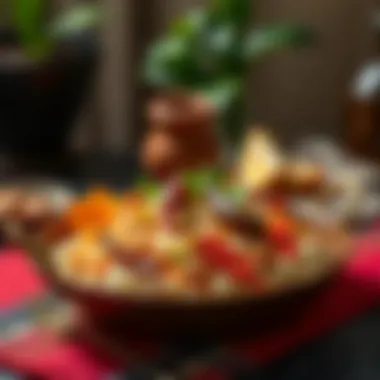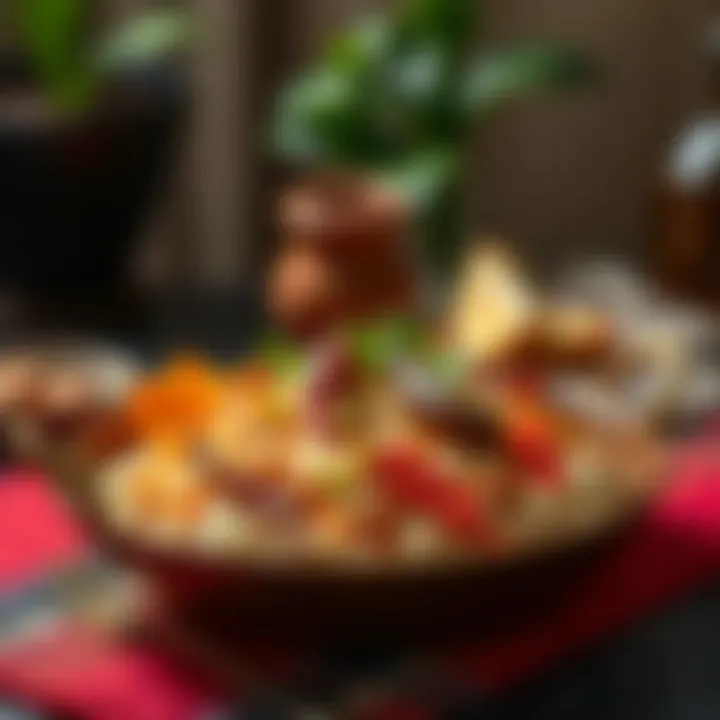Discover the Top Mandi Restaurants in Dubai


Intro
Mandi, a dish steeped in rich history and culture, has found a unique home in Dubai, where it thrives amid the city's extravagant culinary landscape. Known for its sensational blend of spices and tender meat, mandi is not just a meal; it's an experience that encapsulates the flavors of the Arabian Peninsula. With origins rooted deeply in the Hadhramaut region of Yemen, this dish has traveled and evolved, adapting to local tastes while maintaining its authentic essence.
As Dubai emerges as a melting pot of diverse cultures, the demand for authentic experiences, including culinary adventures, rises. Food enthusiasts, expatriates, and tourists swarm the city’s streets, eager to uncover the best mandi restaurants. This article aims to take a deep dive into the vibrant world of mandi, exploring not only where to find it but also uncovering what sets each restaurant apart—from the meticulous sourcing of ingredients to the time-honored cooking techniques that create the delectable dishes we enjoy today.
Whether you’re a resident searching for your new favorite spot or a visitor looking to indulge in local flavors, this guide will equip you with knowledge about Dubai’s best mandi establishments, enhancing your understanding and appreciation of this cherished culinary tradition.
Prelude to Mandi Cuisine
Mandi cuisine forms an essential thread in the rich tapestry of Dubai’s culinary narrative. Its roots stretch deeply into the culinary traditions of the Arabian Peninsula, particularly connecting to Yemen, where it has been a staple for centuries. Exploring this cuisine offers insights that extend beyond mere flavors; it encapsulates social gatherings, rituals, and history. For residents, expatriates, and investors alike, understanding the nuances of mandi is pivotal. This article aims to unravel the layers of this significant dish, illuminating its importance not only as a meal but as a cultural symbol.
Historical Context
The history of mandi is woven into the history of the Arabian Peninsula itself. Originally from Yemen, this dish has traveled through trade routes, forging connections across cultures and regions. It was traditionally prepared by Bedouins, who cooked it in large outdoor pots, using techniques that have been passed down through generations. The dish is not just a meal; it's a communal experience, often served at gatherings and celebrations.
Mandi's name is said to derive from the Arabic word 'and' which means to "cook in a pot." This method was ideal for the nomadic lifestyle, allowing meals to be prepared and shared amongst many. Over decades, the historical significance has evolved, becoming a marker of hospitality and a centerpiece of family dinners, especially during the festive occasions.
The trajectory of mandi, enriched with flavors and techniques, found its way into Dubai, contributing to the city's ever-growing diverse culinary scene. The distinct methods of slow-cooking rice alongside marinated meat bring an authenticity that culinary enthusiasts appreciate greatly.
Cultural Significance
In Arab culture, food carries stories. Mandi epitomizes this narrative; its significance transcends the kitchen and seeps into social dynamics. It is often considered a generous offering, symbolizing hospitality. Serving mandi at a gathering is a gesture that signifies warmth and belonging, inviting family and friends to share an experience rather than just a meal.
The dish reflects regional variations, as different spices and preparation methods can alter its identity. For example, in Dubai, you can encounter mandi made with chicken, lamb, or even fish, making it an adaptable dish that can cater to varied palates.
Moreover, with the influx of cultures in Dubai, mandi has found itself in the spotlight of culinary exploration. Dining establishments proudly display their own unique takes on this dish, while still respecting the age-old traditions. Be it through a modern twist or a faithful representation of its origins, mandi continues to celebrate connections while inviting a sense of nostalgia among those familiar with it.
In sum, understanding the historical and cultural dimensions of mandi enables appreciation not just for the dish itself, but also for the rich heritage it represents in Dubai. As we proceed through this article, we will delve into various aspects of mandi, paving the way for a deeper exploration of Dubai's top mandi restaurants.
Characteristics of Mandi
Understanding the characteristics of Mandi is essential for anyone seeking to appreciate this rich and multifaceted dish. Mandi is more than just a meal; it's a cornerstone of cultural heritage and communal gatherings. It is about flavor profiles that unfold with every bite, cooking techniques passed down through generations, and serving customs that celebrate togetherness. Each element contributes significantly, making mandi the beloved dish that it is today, especially within the dynamic food scene of Dubai.
Ingredients Overview
Mandi's foundational taste lies in its carefully selected ingredients. Typically, the star of the dish is rice, often basmati, known for its long grains and nutty aroma. The rice absorbs the flavorful stock created during cooking. Meat, whether it's chicken, beef, or lamb, is marinated in a blend of spices that can vary widely, but staples include saffron, cardamom, cloves, and cinnamon.
The choice of spices plays a significant role in defining the dish's unique taste. These spices not only elevate the flavors but also provide various health benefits. Tomatoes, onions, and green chilies are also common, bringing a balance of acidity and heat. Some cooks incorporate dried fruits, like raisins or almonds, enhancing the richness and texture of the meal. This diversity in ingredients allows each restaurant to offer its personal twist on this classic, contributing to the overall character of the dish.
Preparation Techniques


Mandi's preparation involves traditional methods that can take hours but result in a deeply satisfying dish. The meat is typically slow-cooked, often in a vessel known as a mandi pot. This process allows the meat to simmer until it becomes tender and flavorful. The rice is usually cooked separately, but it often shares the same pot toward the end, allowing it to absorb the stock infused with spices and meat essence.
Considerable importance is placed on the method of cooking. Some restaurants might utilize a tandoor (clay oven) or an open flame to enhance the smoky flavor. Others may stick to more straightforward methods, emphasizing simplicity and quality of ingredients. Techniques can vary, but the principle of patience and careful attention remains constant, allowing all flavors to meld beautifully. This dedication to preparation is what separates a standard plate of mandi from an extraordinary one, often being the difference between good and unforgettable.
Serving Traditions
Mandi is inherently a communal dish, traditionally served on a large platter and best enjoyed with family and friends. When served, it's common to see diners gathered around, sharing the meal directly from the platter—this practice fosters a sense of community and connection. Oftentimes, the rice is layered under the meat and garnished with caramelized onions, fresh herbs, or even slices of lemon, pointing towards a visual feast as much as a culinary one.
Additionally, locals often serve side dishes like salad or a spicy sauce, allowing guests to personalize their meal. The sharing aspect of mandi is vital; it reflects the values of hospitality prevalent in Middle Eastern cultures. The act of gathering over this meal is a ritual, often linked with celebrations and special occasions.
In summary, the characteristics of Mandi not only define the dish itself but also highlight the cultural practices intertwined with its serving and preparation. By understanding these facets, one can appreciate not just the food but the traditions and stories that come with it.
Top Mandi Restaurants in Dubai
Exploring the realm of mandi restaurants in Dubai is like opening a treasure chest filled with culinary gems. The importance of this topic extends beyond just savoring delectable dishes; it taps into the heart of Dubai’s rich historical tapestry and communal spirit. Mandi, a traditional dish originating from Yemen, has found its way into the fabric of Dubai’s multicultural dining scene. The top restaurants not only serve food but also provide an authentic experience that connects diners to the culture of the region.
Restaurant One: Cuisine and Atmosphere
When you step into Al Mallah, you are immediately struck by its vibrant ambiance that dances between casual and sophisticated. Known for its traditional approach to mandi, the restaurant embraces the classic charm of Middle Eastern dining. The scent of spices wafts through the air, promising a feast that tantalizes the senses. The décor reflects a mix of contemporary design and traditional motifs, making it not just a meal but a multi-layered experience. The menu boasts a variety of chicken and lamb mandi options, each prepared with meticulous attention to detail. Enjoying a plate of mandi here is akin to being welcomed into a family, where every grain of rice tells a story of heritage.
Restaurant Two: Signature Dishes
Next on the list is Bait Al Mandi, famed for its exceptional slow-cooked lamb mandi. The standout dish, marinated with a secret mixture of spices, takes diners on a flavorful journey unlike anything else. The lamb is so tender that it practically falls off the bone, and paired with saffron-infused rice, it creates a harmony of flavors. Bait Al Mandi will give your taste buds a workout, and every bite is packed with layers of taste that speak to its carefully curated recipe. Couple this with a side of tangy garlic sauce, and you'll find yourself questioning every other mandi you've ever had.
Restaurant Three: Unique Offerings
In the bustling heart of the city lies Al Iwan, a hidden gem that serves not only traditional mandi but also innovative variations. A highlight here is the seafood mandi, which includes a selection of fresh prawns and fish cooked to perfection. The unique blend of spices paired with seafood adds a refreshing twist, drawing in both locals and tourists yearning for something different. The ambiance is lively yet cozy, perfect for families or dining out with friends. It’s not just a meal, but rather a culinary adventure that invites one to explore tastes unique to Dubai's coastal essence.
Restaurant Four: Ambiance and Experience
Then there’s the lavish experience offered by Abu Jani. With décor inspired by Arabian Nights, it transports diners to a mystical desert oasis. The mandi here isn’t merely served; it’s presented as a journey—from the moment diners select their ingredients to the last spoonful of rich meat and flavorful rice. Diners can opt to enjoy their meal seated on plush cushions, enhancing the relaxed, festive feel of the place. The restaurant aims to create an experience where it’s not just about eating, but rather sharing in a cultural feast that warms the heart.
Restaurant Five: Community Engagement
Finally, a visit to Sarab Restaurant will not just satisfy your palate but also your desire to contribute to the local community. This eatery is renowned for its active participation in charity events, serving traditional dishes to underprivileged communities on special occasions. Their mandi, a favorite among regulars, is made from locally sourced ingredients, fostering a connection between the restaurant and its community. Eating here goes beyond just enjoying a meal; it’s about being part of something bigger—a movement of cultural integrity and giving back.
“Mandi is more than food; it’s an experience that binds us together.”
As one navigates through these diverse options, it’s clear that the top mandi restaurants in Dubai are not merely feeding the masses; they are nourishing the soul and celebrating a vibrant heritage through every meal.
Adapting Mandi to Modern Palates


Mandi, a dish steeped in tradition, has a way of invoking the aroma and rituals of its origins while allowing for new layers of flavor to emerge in the here and now. As Dubai continues to evolve as a gastronomic hub, the inclusion of contemporary twists on this classic dish is not only a response to changing tastes but also a bridge connecting diverse communities. In exploring how mandi adapts to the demands of modern diners, it becomes critical to understand the trends shaping its evolution without losing the essence that made it iconic.
Fusion Variants
Fusion cuisine offers an exciting playground for chefs keen on reimagining the classic flavors of mandi. By blending curry spices from India or adding elements of Mexican flair, chefs are creating dishes like Tandoori Mandi and Mandi Tacos. These variants often retain the core components of traditional mandi—fragrant rice, marinated meat—but introduce unexpected elements that delight the palate. The result is a remarkable culinary experience that encourages diners to appreciate the integrity of the original while embracing innovation.
The fusion variants can be categorized in various ways:
- Cultural Blends: Chefs might incorporate harissa from North Africa or open the door to East Asian forms, creating Szechuan Mandi, which brings a spicy kick to the table.
- Ingredient Innovation: Using coconut milk instead of traditional stock can lend a different richness to the dish, producing variations like Thai Coconut Mandi.
- Presentation Styles: A modern take often means rethinking how food is served. Instead of the communal platter, consider a more elegant plating, perhaps in mason jars or mini skillets, that appeals to a visually-driven dining audience.
By merging these culinary styles, restaurants in Dubai are appealing to adventurous eaters who appreciate both tradition and creativity, allowing diners to relish a uniqueness that just might spark a renewed love for the dish.
Health-Conscious Options
As modern diners become increasingly health-oriented, there’s a noticeable shift in how traditional dishes are prepared. For instance, the rise of keto and paleo diets has spurred the interest in creating low-carb mandi dishes, which substitute rice with alternatives such as cauliflower or zucchini. These health-conscious adaptations don’t just cater to dietary needs but also help in preserving the vibrant flavors that characterize mandi.
Another noteworthy trend involves sourcing ingredients that are both organic and locally grown. Chefs are opting for grass-fed meats or free-range poultry, enhancing the dish’s nutritional profile while supporting local farmers. Furthermore, the addition of seasonal vegetables into the mix not only adds color and flavor but also contributes to a more balanced meal.
As well, many restaurants are now offering gluten-free options, ensuring that everyone can enjoy their mandi without worry.
- Vegetarian Mandi: This version swaps out meat for a hearty mix of legumes or chickpeas, bursting with spices and complemented by fragrant rice.
- Seasoned with Health in Mind: The use of less oil and a focus on grilling instead of frying can enhance the health quotient without sacrificing taste.
These mindful adaptations reflect a growing understanding of health and wellness among diners, while the essence of mandi remains a comforting staple that connects generations in its enjoyment.
Mandi in Dubai's Culinary Scene
Mandi has carved out a niche in Dubai's culinary landscape, standing tall among a diverse array of international cuisines. The dish, deeply rooted in the Arab tradition, reflects not only a rich cultural heritage but also a unique blend of flavors that have found their place in the modern gastronomic tapestry. With its tantalizing aroma, the practice of cooking mandi has transcended simple sustenance, evolving into a culinary art form that draws both locals and tourists alike.
Comparative Analysis
When we think of Dubai’s culinary scene, it’s impossible to overlook how mandi stacks up against other renowned dishes from around the world. Unlike typical fast food or fine-dining experiences, mandi presents a unique communal aspect. The generous portion sizes encourage sharing and foster a sense of togetherness, reminiscent of family gatherings during festive seasons.
In comparison to biryani, which is also a rice-based dish popularly enjoyed across South Asia and the Middle East, mandi stands apart due to its cooking techniques and flavor profiles. While biryani often involves marinating meat prior to cooking, mandi’s true flavor comes from its slow cooking process, which infuses the rice with juices from the seasoned meats, producing a succulent result that’s hard to resist. Additionally, the spices used in mandi may be milder and focus on simpler flavor combinations compared to the more complex layers found in biryani.
“Mandi is not just about eating; it’s an experience, a ritual.”
— Mandi Enthusiast
To truly appreciate mandi, one must examine its regional interpretations. For instance, Yemeni mandi, which is the traditional form, features a different choice of spices and often includes lamb or chicken that is marinated and cooked in a tandoor, giving it a distinct smoky flavor. In contrast, Dubai has become a melting pot for various cuisines, leading to innovative offerings that incorporate local spices like zaatar or even international influences such as saffron-infused variants.
Preferred establishments in Dubai offer diners not just a plate of delicious rice and meat, but a narrative that sweeps you through the history and culture surrounding mandi.


Role in Food Tourism
As culinary tourism grows in stature, mandi is poised at the forefront of this movement in Dubai. The cosmopolitan nature of the city attracts food lovers from across the globe. Many travelers intentionally seek traditional dishes that resonate with the local culture, making mandi a hot cake on local menus. Tourists often find themselves embarking on culinary tours that focus on traditional cuisine, where mandi serves as the star attraction due to its historical roots and robust flavors.
Restaurants that specialize in this dish frequently incorporate engaging dining experiences, such as showcasing the preparation process or allowing diners to savor meals in traditional Bedouin-style settings. This not only enhances the meal but transports guests to the heart of the culture.
Moreover, local festivals and events sometimes revolve around traditional food, with mandi taking center stage. These gatherings not only bolster community ties but also invite outsiders to understand the significance of the dish—how it’s woven into family traditions, celebrations, and even day-to-day life.
In such a vibrant environment, discerning food enthusiasts can easily find themselves enchanted by the nuances that mandi brings to Dubai’s dining scene, ultimately solidifying its status as an essential element in the narrative of Dubai's culinary landscape.
Recommendations for Mandi Enthusiasts
Mandi cuisine holds a cherished place in the culinary expanse of Dubai, captivating food lovers with its unique flavors and rich history. When exploring the vibrant food scene, recommendations become vital for enthusiasts aiming to savor an authentic experience. Knowing the best times to visit and the importance of making reservations ensures that food lovers not only indulge but also appreciate the cultural significance of this age-old dish.
Best Times to Visit
Timing plays a critical role when it comes to enjoying Mandi in Dubai. While the dish is available year-round, understanding the local dining patterns can enhance your experience significantly.
- Weekend Wonders: Saturdays and Sundays often see a surge in families gathering for lunch or dinner, making it a bustling time in popular restaurants. For an authentic feel, join the local crowd who cherish Mandi as a family tradition.
- Special Occasions: Visits during Eid celebrations or during Ramadan can add a whole new flavor to your experience. Not only is Mandi a popular choice for iftar, but the atmosphere becomes festive and vibrant.
- Off-Peak Hours: If you prefer a quieter experience, consider visiting during weekday afternoons. This timing allows for a peaceful meal where you can engage with the staff or even the chef, making for a memorable encounter.
- Reservations for Special Events: Should you find yourself in the mood for an extravagant meal, making reservations during local food festivals or seasonal events ensures that you won’t miss out on special Mandi variations tailored to celebrate the occasion.
Making Reservations
Making a reservation is often overlooked, yet it’s an essential step for any food enthusiast. Here's why having a table booked in advance matters.
- Busy Establishments: Popular Mandi spots, like Al Majlis and Bukhara, tend to fill up quickly, especially during the dinner rush. Booking will secure not only your spot but also grant you access to seasonal specialties that might run out if you walk in unannounced.
- Specific Preferences: If you have a favorite side dish that pairs well with your Mandi, it’s a good idea to notify the restaurant during your reservation. They might be able to prepare it just the way you like.
- Group Dining: Planning a meal for a larger crowd? Reservations become imperative. It allows the chefs to allocate resources efficiently, ensuring every dish is served hot and to perfection.
- Time Management: With bustling schedules, ensuring your reservation not only saves your time but also allows you to indulge without the stress of waiting or missing out on dining altogether.
"In the world of culinary experiences, the difference between a good meal and a great one often boils down to the little details like timing and planning."
Finale
In wrapping up our exploration of the dynamic mandi scene in Dubai, it’s clear that this dish transcends mere sustenance; it is a cultural experience steeped in tradition, flavor, and community. Understanding the intricate layers of mandi not only enhances one’s dining experience but also connects diners to a wider tapestry of Middle Eastern heritage.
Summary of Findings
Throughout this journey, we've discovered that mandi is much more than a meal; it serves as a focal point for gatherings and celebrations. The restaurants highlighted in this article showcase the artistry involved in crafting the perfect mandi, from selecting quality ingredients to employing traditional cooking techniques. Each establishment we discussed reflects its unique take on the dish, influenced by both regional variations and contemporary adaptations.
- Many restaurants pride themselves on sourcing local spices, enhancing authenticity.
- The preparation methods often involve intricate processes, including the use of clay pots, which significantly focus the flavors.
- Mandi's serving styles also contribute to the overall experience; large platters encourage sharing and bonding, reinforcing community ties.
"Food is more than just nutrition; it’s a chance to forge connections, celebrate heritage, and tell stories."
Future of Mandi in Dubai
The future of mandi in Dubai appears promising as both expatriates and locals continue to embrace this cherished dish. As the culinary landscape evolves, we can expect to see an increase in fusion interpretations that retain the essence of the original while catering to modern tastes. Advances in health-conscious options are likely, with some restaurants exploring plant-based broths or organic ingredients, appealing to a wider audience.
Additionally, food tourism is poised to grow, creating opportunities for immersive culinary experiences around mandi. Notably, cooking classes and culinary tours focusing on traditional dishes like mandi could attract food enthusiasts eager to dive deeper into the craft.
In summary, as Dubai continues to flourish as a global culinary hub, mandi stands as a testament to cultural continuity and culinary evolution. Whether you’re a first-time visitor or a seasoned diner, engaging with this dish offers a tangible connection to the rich heritage of the region and provides an opportunity to savor the flavors that have shaped this gastronomic marvel.















